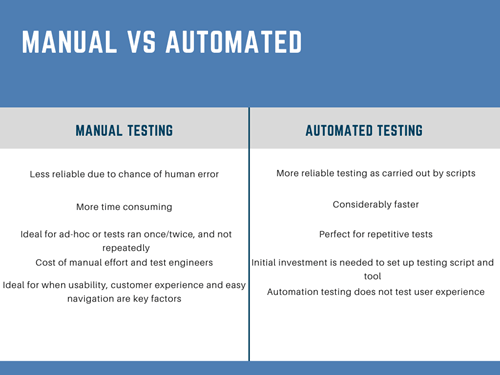14th July 2021
Manual Vs Automated Testing

What's the difference between manual testing and automated testing? We're breaking this down in this blog. And exploring the best type of testing.
While there are many types of application testing, it is broadly classified as two types: Manual Testing and Automated Testing. Understanding the differences means you can decide when to use manual testing and when to use automated. This helps you to optimise the cost and time of the project.
What's the difference between Manual and Automated Testing?
Essentially, manual testing is operated by a human; while automated testing is performed by a computer through pre-scripted tests which are set up by the testers and run automatically. Automated testing comes in handy when performing repetitive tests and checking the code for errors, as it eliminates human error and time. Manual testing is helpful when the tester wants to evaluate the design, functionality and performance of the application.

Can Automated Testing replace Manual Testing?
No, both manual and automated testing is needed in certain circumstances. Manual is important for testing the usability of an application and for complex test cases, while automated testing handles simpler, more repetitive tests.
Here are a few instances when quality assurance teams should use manual testing instead of automation:
1. When flexibility is needed
Although manual testing is not always as accurate as manual testing, manual processes allow testers to have more flexibility in their operations. Because automated testing is inherently useful for repeated cases, this often means that the same code and scripts will be leveraged every time. However, if testers have an idea that they want to work on right away, setting up an automated script takes too much time. In this instance, it would be easier (and faster) to execute this through manual operations.
2. Short-term projects
One of the best times to utilise manual testing is during the initial development stage. It helps to detect issues or visual errors in the initial development stage. This means spending less time and resource on fixing bugs.
Because the initial development phase is unstable, it doesn't make good sense to invest money and people into making automated tests for a software that will likely change.
3. When usability is being tested
The success or failure of an application can be determined by its usability. However, this extends far beyond testing the application for bugs and defects. For example, an automated test can easily find errors in code, but it cannot say how the user would interact with a certain feature, how it displays across devices and how people will be able to navigate the program.
If the test engineer tests the application manually, he/she can test the application from an end-user perspective and get more familiar with the product, which helps to identify how the software can be streamlined.
Test everything with PSP
PSP has more than 120 years' combined experience providing bespoke across a range of sectors including: Chartered institutes, membership, law, finance, supply chain management and eCommerce.
The testing phase is a crucial stage of every one of our products. As well as checking for snags and ensuring the initial requirements are met, we also test the functionality of the application, the end-user experiences and explore ways sequences can be shortened or streamlined.
Our clients have seen improved speed-to-market times, improved customer experience, streamlined application performance, and unfailing quality assurance support.
Our experienced in-house team can cover everything you need in QA outsourcing. Which means we can provide all services in one place and you do not need to look elsewhere for more complex technical tasks.
Find out more about our Software Testing Services here: psp-it.co.uk/services/software-application-testing-centre/
Where to find us
We'd love to welcome you into our office! We're only 20 miles north of Peterborough, conveniently just off the A16.
Carver House
Apex Court, Elsoms Way
Pinchbeck
Lincolnshire
PE11 3UL
